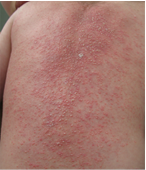 Associate Professor Kazumitsu Sugiura, Professor Masashi Akiyama and their co-researchers1 determined that the majority of Generalized Pustular Psoriasis (GPP) is caused by a deficiency in the interleukin 36 receptor antagonist (IL-36RA). Their paper was published online in Journal of Investigative Dermatology2 on May 22, 2013.
Associate Professor Kazumitsu Sugiura, Professor Masashi Akiyama and their co-researchers1 determined that the majority of Generalized Pustular Psoriasis (GPP) is caused by a deficiency in the interleukin 36 receptor antagonist (IL-36RA). Their paper was published online in Journal of Investigative Dermatology2 on May 22, 2013.
GPP is an inflammatory skin disorder, and has been designated an intractable disease by the Ministry of Health, Labour and Welfare. There have been relatively few cases, and no cure is known. It covers the entire body with eruptions of pustules and triggers the rapid onset of fever. It usually occurs in childhood and the thirties, and once it develops, patients suffer from multiple relapses. It often results in complications, and at worst case in death. In 2011, researchers detected that in Tunisia a rare type of GPP, Familial GPP, is caused by mutations of IL-36RA; however, the cause of the other types was thought to be different.
IL-36 is a protein that provokes inflammation; it becomes active through binding with the receptor. Usually the receptor antagonist prevents IL-36 from integrating with the receptor, but when the antagonist is absent, IL-36 triggers inflammatory dermatitis. The research group analyzed genetic mutations coding IL-36RA in GPP patients. The results showed that 80% of the patients had mutations in IL-36RA, and thus the group concluded that IL-36 is the etiology of GPP. It is widely expected that from now on development of medical cures for GPP will advance on a worldwide basis.
1. Joint research with 11 institutions in Japan
2. A journal jointly published by the Society for Investigative Dermatology and European Society for Dermatological Research
Associate Professor Kazumitsu Sugiura
Associate Professor Sugiura has tackled research on epidermal keratinocytes and hereditary skin disorders. He was astonished by the discovery of the etiology of familial GPP in 2011, and came to think that GPP also has a genetic origin. Thanks to the cooperation of patients, he determined the cause of GPP to be IL-36RA. He aims to be of help to patients with his research and clinical practice.
Outlook for the Future
"In the short run, I would like to provide a definite diagnosis of GPP by conducting genetic screening. Also, some skin disorders cannot be diagnosed accurately by a normal medical examination. I would like to detect the causes of these difficult diseases using genetic methods."
Message to Young Students
 "Thanks to the patients' help, we were able to determine the causative agent of GPP. Dermatologists do their research hand in hand with patients, and our research can contribute directly to patient care. If you want to take on both clinical practice and research with your best efforts, the department of dermatology can provide the optimal environment."
"Thanks to the patients' help, we were able to determine the causative agent of GPP. Dermatologists do their research hand in hand with patients, and our research can contribute directly to patient care. If you want to take on both clinical practice and research with your best efforts, the department of dermatology can provide the optimal environment."
Links
Research Information
Associate Professor Kazumitsu Sugiura